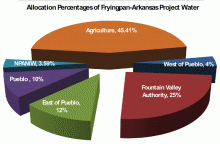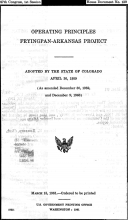- Home
- Admin
- Meetings
- Fry-Ark Project
- Projects
- Water Management
- Agriculture Conservation
- Arkansas River Basin Water Rights
- Conservation Plans
- Conservation & Education
- Education
- Fryingpan-Arkansas Project Water Import Tracking
- Inclusion into the Southeastern Colorado Water Conservancy District
- Legislation
- The Allocation of Fryingpan-Arkansas Project Water & Project Water Return Flows
- RRA
- Snow Pack Monitoring
- Water Conservation BMP Tool Box
- Winter Water Storage
- Water Wise Gardening
- Login
The Allocation of Fryingpan-Arkansas Project Water & Project Water Return Flows
The Agricuture First Right of Refusal (AFRR) Program to revise the Policy Concerning Sales of Return Flows from Fry-Ark Project Water presentation click here.
The Allocation of Fryingpan-Arkansas Project Water (Project water) and Project water return flows (return flows) is governed by the following documents:
The “Operating Principles Fryingpan-Arkansas Project” adopted by the State of Colorado and incorporated into the Fryingpan-Arkansas Project Act by Reference.
On November 29, 1979, the District Board of Directors unanimously approved the Allocation Principles, Findings Determinations, and Resolutions. This document set out the principles for allocation of Fryingpan-Arkansas Project water available to the District between the Municipal and Agricultural water users and the use of Project storage by municipal water users. The District's repayment contract with the United States governs the Reservoir Spill Order for water in Fry-Ark Project facilities, as well as setting the price rate charged for Project water.
The District also has a Water Allocation Policy dated March 17, 2022.
In March of each year appropriate letters and forms are mailed to eligible entities offering them the opportunity to apply for an allocation of Project water.
The District reviews the applications for Project water and return flows water. The application are sorted by Municipal, Irrigation, and Not Previously Allocated Non-Irrigation Water (NPANI) and then by first use Project water and return flows. Using Reclamation’s May Project water forecast, the District calculates the proposed allocations based upon the documents referenced above and the requests.

Use and Reuse of Project Water--
Pursuant to its “Repayment Contract” ( Link to attached – USBR SECWCD Repayment Contract )with the United States, the District retains dominion and control over Return Flows. The District has made Return Flows from the use of Project water available for use by eligible entities within the District boundariesReturn Flows are allocated differently for municipal and irrigation use. Return Flows are allocated in accordance with the Southeastern Colorado Water Activity Enterprise “Policy Concerning Sale of Return Flows from Fryingpan-Arkansas Project Waters.”Municipal entities may purchase Return Flows they generate and then exchange them into storage, or use them to replace well depletions. Because of carryover storage, there is no direct correlation between Municipal Project water allocation and subsequent use of Project water. The municipal entities report to SECWCD the measured Return Flows they generate and SECWCD bills them quarterly for that water.Most municipal entities east of Pueblo use their Project water allocation to replace depletions to the river caused by their municipal well pumping, thus there are no Return Flows from this type of use of Project water.Irrigation Return Flows are typically allocated to well augmentation associations for replacement of depletions to the stream created by out of priority use of their member’s irrigation wells The amount of Return Flows available is usually based upon 35 percent of the headgate deliveries to each canal. The Return Flows are then allocated to the associations based upon acreage, whether the wells are supplemental (i.e. have ditch water rights too) or sole source wells with no other water sources, in addition to the type of well, the type of irrigation (flood, sprinkler, or drip) is used in calculating the agricultural Return Flow allocations.While the District allocates Project water, Reclamation is responsible for the accounting and release of Project water. The District provides Reclamation and the State Division 2 Engineer's Office with the listing of the annual allocation of Project water. Deliveries are then coordinated by Reclamation in communication with the Division No. 2 Engineer's Office as requests are made by ditch companies and municipalities. The price for Fry-Ark Project water is determined by the Bureau of Reclamation as directed by Reclamation policy and the District’s repayment contract. Rates are subject to adjustment depending upon the Ability to Pay Study and Repayment Analysis, which are conducted by Reclamation every four years. These studies first determine the irrigators’ ability to pay for project water by assessing the economic condition of the average farm operation within the District.’
First, the 3.59 percent NPANI water allocation is calculated. This is done because NPANI water cannot be allocated for irrigation. NPANI water is the Project water percentage that had once been allocated to irrigate lands that have since had the water sold off the land and removed from the ditch or canal system for Municipal use.
NPANI water is currently distributed as shown below
| NPANIW Distribution (Percentage of Total Allocation) | Percent |
| Fountain Valley Authority | 0.45% |
| Arkansas Valley Cities, Towns, and Entities lying East of Pueblo | 0.73% |
| Arkansas Valley Cities, Towns, and Entities lying West of Pueblo | 0.27% |
| Colorado Springs Replacement | 1.45% |
| City of Manitou Springs | 0.35% |
| Pueblo West Metropolitan District | 0.34% |
If the 3.59 percent of the amount of water available for allocation exceeds the NPANI water requests this water is then moved to the Municipal allocation.
The Municipal allocation of 51 percent plus any non-allocated NPANI water is calculated as follows:
- 25% to the Fountain Valley Authority members
- 12% to municipal entities east of the City of Pueblo
- 10% to the City of Pueblo
- 4% to municipal entities west of Pueblo
- Excess NPANI water pro-rata to the above areas
If the percentage allocated to a specific area exceeds the requests for Project water in that area the excess is then allocated to the other allocation areas pro-rata based on their percentages.
If within any single allocation area, any entity’s request is less than their individual allocation percentage the excess is then allocated pro-rata to the other entities within that area.
If all municipal requests for Project water are met, any excess water is then available to agriculture for the irrigation allocation.
Next, Project water for agriculture irrigation is allocated. This allocation is made only after the municipal requests are met up to 51 percent and the NPANI water requests are met, up the 3.59 percent of the annual Project yield. To be as equitable as possible, allocation of irrigation Project water is done proportionately on a portion of an acre-foot per acre eligible to receive Project water as determined by Reclamation Reform Act (RRA) reporting. Initially the District calculates the amount of Project water available per eligible acre by dividing the total amount of Project water available by the total eligible acres. This number is then used to calculate the allocation to each ditch. As with the municipal entities, if any irrigation entity’s request is met the excess allocation is then recalculated for the entities whose requests were not met. This may take several iterations to allocate all of the irrigation Project water.
The Project Water Allocation Policy requires, unless waived by the Board, 80 percent of Project water allocated to each entity for irrigation be used by November 15 of the year allocated and the remaining 20 percent must be used by May 1 of the following year.
- Fry-Ark Supplemental Water Info Sheet 2025 Project Water and Return Flow Allocations
- AG Project Water Application for 2025
- Conditions Applying to the Allocation of 2025 Ag Project Water
- AG Return Flow Application
- AG Return Flow Sales Process
- Municipal/Domestic Application 2025 Fry-Ark Project Water
- Conditions Applying to the Allocation of 2025 Municipal Project Water

